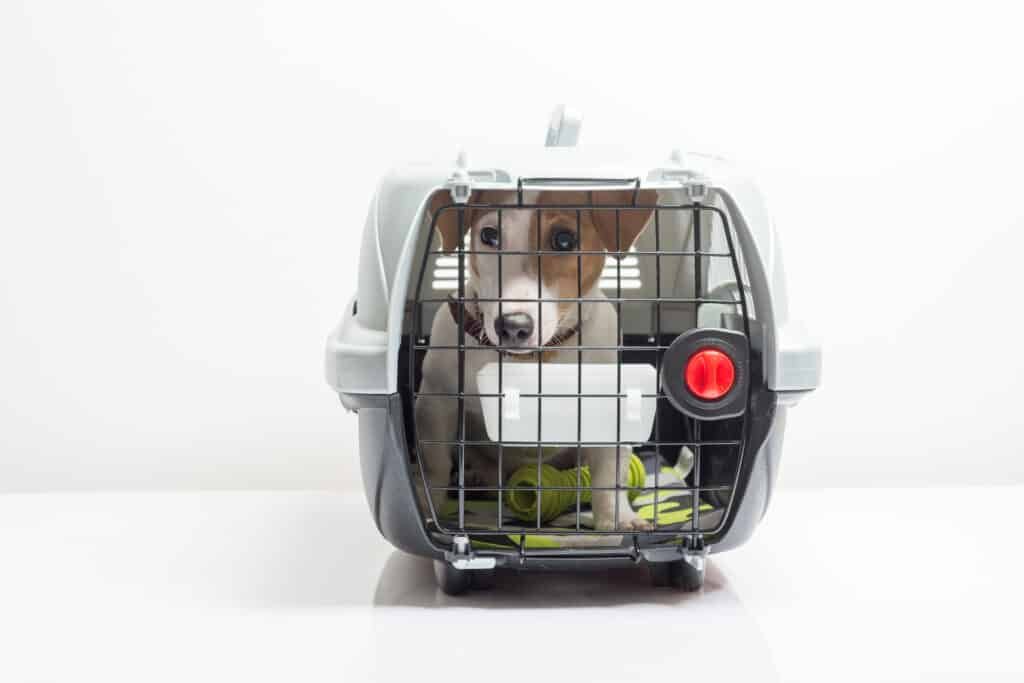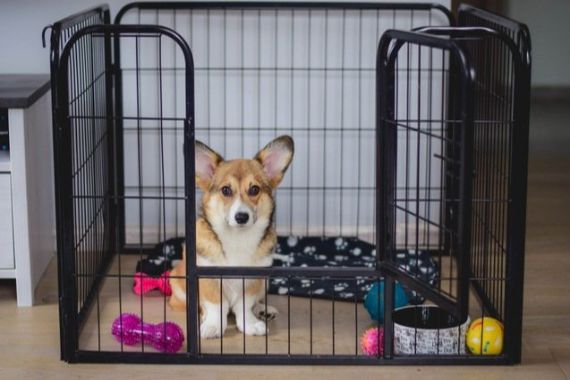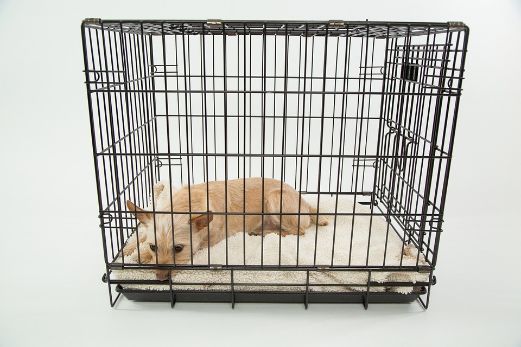We're an affiliate
We hope you love the products we recommend! Just so you know, we may collect a share of sales or other compensation from the links on this page at no additional cost to you. Thank you if you use our links, we really appreciate it!
Are you in the process of searching for a doggy crate? Congratulations, your dog too needs a space to call home. But you are probably asking yourself ‘what crate size do I need for my dog?
Pet parents should always go all out to choose the right-sized crate for their furry friends. This is an important decision because it will impact your pup’s safety and comfort while staying inside.
Getting the right-sized crate for your dog will probably make all the difference depending on the situation you are intending to use it for.
Whether you want to contain your new puppy or you want to housetrain them, there’s a lot that you can do with a dog crate.
Follow us along as we highlight the factors you need to consider when choosing a good crate for your dog.
Look out for our dog chart that will show the dog breed information and crate size recommendation.
How Big Should a Dog Crate Be?
A right-sized crate for your dog should be that which corresponds to their size and personality.
For your pup to be comfortable in their crate, they should be able to stand up, make a complete turn, sit, and sleep without feeling restrained.
On the bare minimum, the height of the crate should be at least 1 inch taller than your pup’s shoulder height while standing. The length should be at least 3 inches longer than your dog’s length from the nose to the tail’s base.
If you are buying a crate for your puppy, you can as well get an adjustable option (with panels) that will allow you to increase the size to match the dog’s growth and development.
Factors to Consider When Choosing a Crate Size
You should keep the following factors in mind when looking for the appropriate crate for your dog:
1. Your dog’s breed and size
Large dog breeds will need larger crates than their smaller counterparts and vice versa. If you get this wrong, then your furry friend will either find the crate too small or there’ll be too much room to move around.

2. Puppy’s Potential to grow
If you are looking for a crate to housetrain your puppy, then you should mind their constant growth.
If you get a very small crate for a young pooch, then they might soon outgrow the accessory and you may be required to get another one.
3. Comfort
A dog’s crate should not be boring, it needs to provide the comfort needed to keep your pup happy and healthy.
You can spice up their comfort by placing a comfy bed inside the crate and covering the flooring space with pee pads to protect your floor.
4. Purpose
What do you intend to use the crate for? If you are planning on training your dog, then you need to consider a larger crate that will allow them a free space to move around while following your instructions.
If the crate is solely for containment, then you can keep it minimal but remember to guarantee them some space for comfort and turning around.
A traveling crate needs not to be too big, just a small-sized mesh with a comfy interior will get the work done. Ensure you get one that can fit in the back seat of your vehicle.
5. Weight limit of the crate
You need to know the maximum weight your desired crate can accommodate before making a purchase decision.
If you are planning to house single or multiple dogs, you must be mindful of exceeding what the crate can hold at a go especially if you are using it for travels.
6. Your dog’s personality
You should always have your dog’s personality in mind when sourcing a good crate for them. If you have a hyperactive pup, then you should get a large cage made with strong and durable materials.
The heavy-duty crate should be able to withstand the high-energy games from your pup and the subsequent wear and tear. This will give them room to play and stay active while being contained in a safe space.
For pet parents with relaxed dogs, you have the leeway to go for a modest right-sized crate for your intended use.
5 Types of Dog Crates
The following are the major types of dog crates that you will find in the market today:
1. Metal or Wire dog crates
These are the most common types of dog crates among pet parents. They have become so popular because of their top-notch ventilation, an easy visibility for supervision, and adaptability.
They are created with metal wires and some of them have plastic trays at the bottom for easier cleaning and floor protection.
Most of them are collapsible hence they can be folded up for easy storage and ideal traveling with your pup.
2. Plastic Dog Crates
Most plastic crates for dogs have been made in compliance with airline pet carrier requirements. They are constructed to be lightweight, durable, and easy for moving around with your pet.

They are a good option for dogs who love chewing on stuff or escaping. However, plastic crates don’t offer much ventilation and visibility like the wire ones.
3. Soft-sided dog crates
These types of dog crates are made from fabric materials that have been overlaid on a metallic frame. They are lightweight and ideal for short trips with your dog and vet visits.
Soft padded crates are good for small and anxious dogs who might need comfort in an enclosed space as they move around with you.
If you have a heavy chewer, then you may want to consider skipping these types because your pup could easily tear the fabric.
Their durability may not be as good as the plastic and wire cages but they get the job done and in style.
4. Heavy-Duty Dog Crates
These are crates that have been made with strong materials such as steel and aluminum. They are suitable for giant breed dogs or those who might be prone to aggression, excessive chewing, and escaping easily.
Heavy-duty dog crates have been manufactured to withstand the most hard-hitting dogs during training and they are mostly used by canine behaviorists in their stores.
5. Furniture Dog Crates
These are stylish dog crates that have been made to blend with your home interior’s décor. They offer a more permanent and safer place for your dog to retreat after a long day within your house.
Furniture-styled dog crates are mostly made from wood and a combination of other sturdy materials with a decorative finish and style.
They can also be used as a tabletop, bookshelf, or even accessory store for your dog’s items, making them good furniture to be placed in various rooms within the house.
Dog Crate Size Chart
| Dog crate Sizes | Ideal Dimensions range of the crate | Max. Dog Height Range | Max. Dog Length Range | Max. Dog weight | Suitable Breeds |
| XS | 18-22 inches | 10-12 inches | 15-17 inches | 10 pounds | Chihuahuas, Yorkies, Maltese, Pomeranians, and similar toy breeds |
| S | 23-24 inches | 14-16 inches | 20-22 inches | 20 pounds | Miniature poodle, Cocker Spaniels, Boston Terriers, and similar small breeds |
| M | 25-30 inches | 18-20 inches | 23-28 inches | 40 pounds | Pit bulls, Australian Shepherds, Border Collies, and other medium breeds |
| L | 31-36 inches | 22-24 inches | 29-34 inches | 70 pounds | Irish setter, Irish red, English setter and other similar breeds |
| XL | 37- 42 inches | 26 – 28 inches | 35- 40 inches | 90 pounds | Labrador Retrievers, Golden Retrievers, and German Shepherds and other large breeds. |
| XXL | 48 inches and higher | 30 inches | 46 inches | Above 90 pounds | Great Danes, Mastiffs, Great Pyrenees, Saint Bernards, and other Giant breeds. |
Know your dog’s breed
Our chart provides a rough estimation of the dog breeds that can fit in various crate sizes. You can then narrow it down to the ideal crate for your specific breed by looking at your dog’s weight and the maximum height & length.
Note: This chart should only provide a general guide on the dog crate sizes and dimensions for all dog breeds categories.
You should always take your dog’s measurements before deciding on the specific product you want.
Consider a Crate Based on Your Dog’s Adult Size
If you have a puppy, you can consider purchasing a crate based on their full-grown size. You can estimate this based on their breed or breed mix information.

You can also reach out to a breeder for more in-depth knowledge about your puppy’s expected growth and how huge or small they will likely be in their adulthood.
Crates for adult dogs might indeed be overwhelming when using them for puppies. You can always look for the ones that have divider panels if you want to contain them in a smaller space.
Keep adjusting the panels as your puppy grows to ensure you don’t get it wrong on the space size for training and containment.
How To Measure a Dog for A Crate?
What you need:
- A loose 60-inch tape measure
- Your relaxed dog on a flat surface
- A notepad
Body Length
To determine the appropriate length of your dog’s crate, you will have to measure your dog from the start of the nose to the start of the tail while they’re standing firm.
You should avoid measuring to the end of the tail since this may give the wrong size information and will result in a wrong choice.
You will then add 4 inches to the measurements obtained and this will give you the appropriate length idea of the crate.
Body Height
Have your dog sit down on a leveled surface and let their head face up. You will then take measurements from the floor level to the very top of their head.
Add 4 inches to the measurements obtained to get your desired crate’s height. If your dog loves to jump especially when they’re happy, you can add more inches to give them a safe headroom for a safe jump.
These two body measurements are enough to give you an idea of the most appropriate crate size for them. You can adjust the allowable measurements depending on your dog’s activity level and what you intend to do with the crate.
Weight limit
All crate manufacturers will indicate the recommended weight limit for the specific product in their packaging.
You need to be sure that your dog’s weight falls within this limit especially if you will be traveling with your dog in the crate.
How Much Room Should a Dog Have in a Crate?
The space your dog needs in a crate will depend on what you want to do with them.
It is good to keep them comfortable at all times when inside a crate for their physical and mental health.
As such, they should have enough space to stand up, make a few turns, sit down, and sleep. If your dog cannot do all of these inside their area then that product is too small for them.
The crate should also not be too large, especially the ones for house training puppies. A roomie crate will confuse your little pooch during potty training as they will have a whole floor space to pee even while inside.

If you are using the doghouse as a containment space for your pup, then there should be enough room inside to fit a comfy bed on one end, a bathroom on the other, food accessories, and some toys.
Frequently Asked Questions (FAQs)
1. Can a Crate be too big for a Dog?
Yes, with highly upscaled measurements, a crate can definitely be too big for a dog. The product can be considered to be gigantic if it has additional space that the dog does not need.
The interior space could range from a few more square inches to square feet giving the dog too much room.
2. What happens if the Crate is too big?
Too much free space in the crate can make your furry friend lack a sense of security and might try to chew on the walls or escape.
A very spacious crate is also not very good when teaching your dog some basic skills. They may quickly lose concentration and hence make the process even harder.
You can scale down a big crate by fashioning a DIY panel that will partition the interior into two or more parts.
You can then use one portion to contain your dog and the other(s) to store their food and other items.
If you have multiple dogs, you can also house them in the bigger crate so long as you ensure they get enough shared space. If you choose to go this way, you need to also ensure that each pup has their accessories.
3. At what age do you stop using a dog crate?
This will vary depending on your dog’s personality, how fast they get fully trained, and what you used the crate for.
Most dogs will fully mature after around 2 years, and at this time, you can comfortably leave them within the house unsupervised.
Some dogs would always love spending time in their crates even after their training period lapses. Their crates have become part of their indoor kennels.
For such breeds, you can allow them to stay inside the crate at will but just remember to leave the door open so they can go in and out on their own terms. We recommend getting a furniture-styled crate for this purpose.
4. How many hours is it OK to Crate a Dog?
Puppies (3 months and older) can be put in a crate for between 3 to 5 hours depending on their age and personalities. Adult dogs could spend between 6 to 8 hours inside the crate a day.
Doing more than 8 hours at any particular moment could predispose them to stress and separation anxiety which could only make their mental health worse.
Aside from the well-being concerns, your dog could also feel lonely, isolated, and despised when they overstay in their crates. This can lead to social issues and potential harm to your bond.
Final Thoughts
When it comes to the question of ‘what crate size do I need for my dog?’, it is always important to keep your dog’s comfort and security in mind.
Don’t go for a product that will make your furry friend feel cramped up and stuffed with little ability to do anything while inside.
Equally, you should not go for a very roomy crate that makes your dog feel insecure and set hurdles in the training process.
The magic bullet is to get your dog’s measurements, weight, and personality right before deciding on the best-sized crate for them.
If you have an anxious dog, then have a look at our crates for dogs with anxiety.
Laura is the founder of Furs'n'Paws. She is a also a pet writer and expert with more than 20 years of experience of working with dogs and cats. She developed a very strong love for animals at a young age. Her passion led her to establish a thriving pet sitting and dog walking business in Dubai. As an expert in pet training, behavior, and nutrition, Laura is committed to helping pet owners and pet lovers by offering high-quality information on a wide range of topics.



No responses yet